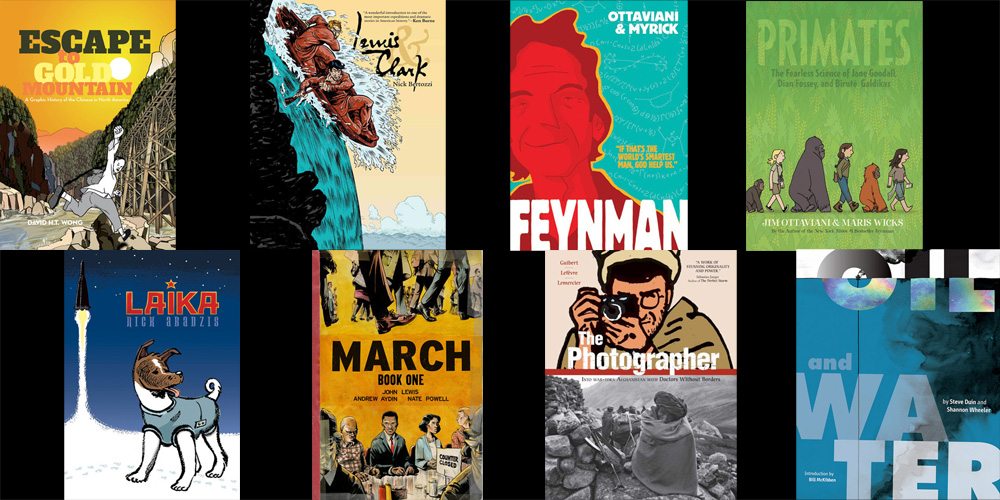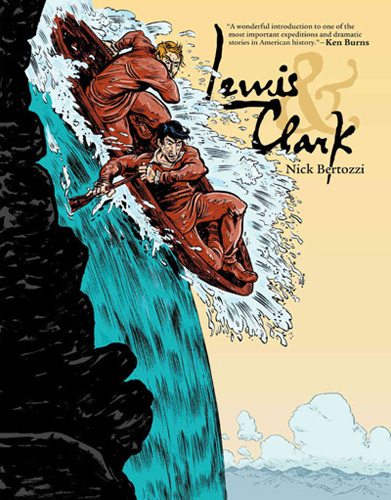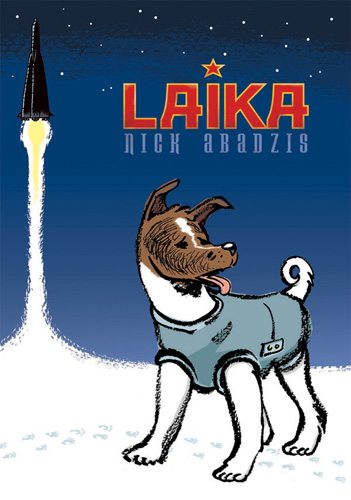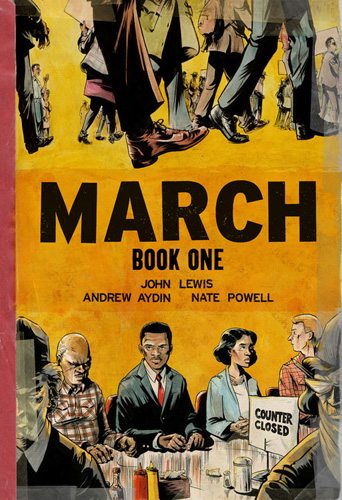After the fiction-based list from last time, I wanted to spend a week or two talking about some great non-fiction comics. Non-fiction writing, particularly biographies and coverage of historical events, often tends to be accompanied by pictures: illustrations and photography help to establish events in our minds by showing us what people and places look like. For the same reason, comics can be a great way to immerse the reader in these very real worlds, experiencing these very real events.
Of course, just as with a movie “based on a true story,” a comic book retelling of a historical event usually has some fiction mixed in with the fact. Writers and artists take liberties to make the number of characters manageable, or to avoid lots of tangents and loose ends in the storytelling.
Here are several comics about real events and people. I’ve arranged them in roughly chronological order, although some books span a wide time range.
Escape to Gold Mountain – David H. T. Wong
I’m a little hesitant to include this first book on the list, because personally I wasn’t particularly impressed by the quality of the artwork—and of course the art is a significant part of a comic book. However, I think the story itself is one that is not very commonly seen. Escape to Gold Mountain is about how the Chinese came to North America, told from the perspective of a fictional family that spans several generations. The history of Chinese in both America and Canada is a long, sordid tale, including the 1882 Chinese Exclusion Act, the only time a particular ethnicity was singled out and banned from immigrating to America.
Wong, an Asian Canadian community activist, traces over a century of challenges that the Chinese faced in their new home, as well as the way that some persevered so that future generations could have a better life. Although it may be the least polished comic book on today’s list, it’s a tale that may be largely unknown to many, and the comic book format does make it more engaging than a dense academic report.
More information is available at EscapeToGoldMountain.com.
Lewis & Clark – Nick Bertozzi
History teachers, do not fear: despite the attention-grabbing cover that appears to show Meriwether Lewis and William Clark plunging over a waterfall, this comic book retelling of their journey is not sensationalized nonsense. Of course, artist Nick Bertozzi does make sure to include some exciting adventure scenes, but for the most part Lewis & Clark is a pretty faithful retelling. And, after all, the story of their expedition hardly needs exaggeration—it was so unlikely to succeed, and yet Lewis and Clark made it to the Pacific and back again.
My older daughter just finished studying Lewis & Clark last school year, so she recognized many of the figures in the story, but this version also relates unflattering things that aren’t always taught in history class, like Lewis’ depression and the incompetence of Mister Charbonneau, Sacagawea’s French husband. Thoroughly entertaining and educational.
Feynman – Jim Ottaviani & Leland Myrick
Richard Feynman is a fascinating character, and Ottaviani and Myrick do a wonderful job with this biography. Mostly chronological (with a little bit of skipping around), it follows Feynman’s career from college to the atomic bomb to quantum electrodynamics. Befitting his quirky personality, we get stories not just of his work on the bomb but also his exploits in safecracking and, for lack of a better word, tormenting his Army supervisors.
The book is brilliantly written. Ottaviani makes Feynman himself the narrator, sometimes with the comics equivalent of a voiceover and sometimes conveying information through conversations Feynman is having with other people. Because it’s comics, Myrick is able to take liberties with the visuals, at times overlaying Feynman’s inner thoughts on top of reality, reminiscent of the visual effects in A Beautiful Mind. There are even some sections about QED which show, briefly and in layman’s terms, what Feynman’s prize-winning work was all about. These are taken from a series of lectures he gave in New Zealand, in his attempt to explain his work to his non-scientist friend Alix. Everything is meticulously researched, and at the end Ottaviani provides a lengthy bibliography showing where he got his information and giving the reader a starting point for further reading about Feynman.
Myrick’s artwork looks simply drawn and is fun to look at. You quickly get used to Feynman’s crooked grin and messy hair. There’s just enough details to evoke the scene but it’s not going for photorealism or Marvel-style dynamic action. Instead, you get a style that seems perfectly suited for relating a biography: it’s true enough that you know these are real events, but abstracted enough that you don’t assume everything is verbatim, either.
Whether you’re a huge fan of Feynman or, like me, just dipping your toes in the subject, Feynman is an excellent portrait of a fascinating man. After reading this, I’m very interested in following up with some of Feynman’s own writings, although my physics is a bit rusty.
Primates – Jim Ottaviani & Maris Wicks
Ottaviani is an expert at adapting the stories of scientific discoveries for comics, and Primates is another great example of that. It follows three remarkable women and the primates they studied: Jane Goodall and chimpanzees, Dian Fossey and mountain gorillas, and Biruté Galdikas and orangutans. Ottaviani admits to simplifying and tidying up the facts to make it more storylike, but explains that they got “all the significant details right.” And for further reading, there’s a bibliography provided.
The story of Goodall, Fossey, and Galdikas is another one that seems so unlikely: it’s full of crazy decisions, a lot of determination, and some pretty funny situations. Wicks’ artwork makes everyone kind of cute, but it serves the story well. My only complaint about Primates is that I wish it were about three times as long.
Laika – Nick Abadzis
In October 1957, Russia shocked the world by being the first to launch a manmade satellite into orbit. But for Premier Kruschev, it wasn’t enough to beat America into space—he wanted another launch to celebrate 40th anniversary of the October Revolution, merely a month away. It was too soon to put a man in space, so Korolev decided to send a dog instead … and Laika became the most famous dog in history.
Abadzis combines fact and fiction to give a closer look at the dog who went into space. It’s obvious that a lot of research went into the book, but he also gives Laika a voice and a history beyond being just a stray dog found in Moscow. It wasn’t until 2002 that it was made public that Laika actually died within hours of launch—the public had been told that she lived for several days before oxygen ran out—and Abadzis includes this in the story. The story is largely told through the eyes of Yelena Dubrovsky, a fictional dog handler at the Institute of Aviation Medicine.
Although Laika isn’t an entirely true account, it is a more personal look at this small portion of the space race between Russia and the U.S.
March (Book One) – John Lewis, Andrew Aydin, Nate Powell
Congressman John Lewis is the last living speaker from the 1963 March on Washington, at which Martin Luther King, Jr. gave his “I Have a Dream” speech. He was only 23 at the time, but was already deeply involved in the civil rights movement. He was arrested more than 40 times, but persevered, and has been a U.S. Representative since 1986.
Now, he’s making history again by telling his story in the form of a graphic novel, March. Book One was released this year at Comic-Con, and Rep. Lewis attended the convention, drawing such huge crowds for autographs that Comic-Con almost had to shut down the line for safety reasons. The publisher, Top Shelf, noted that they sold more copies of March on the first day than they’d ever sold of any other book in their fifteen years at Comic-Con.
March is told in Lewis’ voice, starting in the near past at Barack Obama’s inauguration, and then moving back to his childhood and then his involvement in the civil rights movement. Book One goes as far as May 10, 1960, when six downtown Nashville stores served food to black customers for the first time, but the story will ultimately tell of both the March on Washington as well as the Bloody Sunday march in Alabama on March 7, 1965.
Andrew Aydin, the co-author, serves in Lewis’ office and was previously Lewis’ communications director and press secretary. The artist, Nate Powell, is well known for his own comics like Any Empire and Swallow Me Whole, and his drawings are very expressive and immerse you in the struggles of these young black students as they struggle to change the world.
It’s an incredible story, and an incredible way to tell it—a trilogy about a real-life superhero.
The Photographer – Emmanuel Guibert, Didier Lefèvre, Frédéric Lemercier
In 1986, a young French photographer named Didier Lefèvre took a trip to Afghanistan during the war between the Soviet Union and the Afghan Mujahideen. He was on an assignment to document a Doctors Without Borders mission, and he traveled with a group of doctors and nurses—and Mujahideen arms smugglers. He took enough photos to fill 130 rolls of film, of which only six were published in the French newspaper Libération. However, he told his story to his friend Emmanuel Guibert, and thirteen years later Guibert proposed that they create a book based on his journey.
The Photographer is the result of that collaboration, which is a mix of comics and photographs. The book was originally published in three parts in French, with an English translation by Alexis Siegel in 2009. The oversized format of the book showcases Lefèvre’s photography, particularly pages of contact sheets that give you a sense of how he would document events.
The first two parts, showing the journey into northern Afghanistan and then his time in the small village of Zaragandara where the Doctors Without Borders set up their small hospital, offer a close look at the dangers the group faced every time they entered the country and the challenges of practicing wartime medicine outside of sanitary hospital rooms. But the third part is perhaps the most terrifying: Lefèvre decides to make his own way back to Pakistan because the group he is with wants to take a longer route home. He is supposed to be provided with a horse and an escort, but he does not speak the language and runs into all sorts of difficulties, including being abandoned by his escort and then “rescued” by some fighters who then extort him. It’s amazing that he made it back to France alive at all.
Most comics can be read very quickly, even many of the others on this list, but The Photographer is so packed—with words, with photographs, with emotions—that I pored over it for several hours before I finished.
Oil and Water – Steve Duin & Shannon Wheeler
In 2010, a group of Oregonians traveled to the Gulf Coast to see firsthand the results of the Deepwater Horizon oil spill. Among them were Steve Duin, a columnist for The Oregonian, and Shannon Wheeler, a cartoonist known more for his New Yorker cartoons and Too Much Coffee Man than comics journalism. Their goal wasn’t to try to fix the worst environmental disaster in US history, but simply to provide a glimpse of what things were really like. As one of the characters says in Oil and Water, “to bear witness.”
There are some funny moments in the book, but they tend to be of the painful sort—the type of groaners that result from well-meaning do-gooders encountering people with whom they have very little in common. Although Duin and Wheeler do not portray themselves in the book—the ten travelers are amalgamations of the actual people who went—you can tell that they are at times embarrassed by things that were said and assumptions that were made.
From cleaning up oil-soaked pelicans to spending time on a crabbing boat, the story meanders through areas affected by the spill. It’s a fiction, but one that springs from actually being there and talking to people and understanding that the real story is often more complex than the one we usually tell. Oil and Water doesn’t end with a clear lesson, loose ends tied up. If anything, it leaves you with more questions—and perhaps that’s exactly what Duin and Wheeler were after.
As always, this is just a small list, and is far from comprehensive. For instance, I’ve only read a little bit of Joe Sacco, but he was one of the first to do comics journalism and is worth checking out. I’ve also enjoyed several of Jim Ottaviani’s other books. Next week I’ll cover a few more books that cover non-fiction subject matter, often using fiction as a framework.
The previous posts in the series:
- Part 1: The Usual Suspects
- Part 2: Memorable Memoirs
- Part 3: Spotlight on Will Eisner
- Part 4: Avoiding the Subject
- Part 5: Truly Super Heroes
- Part 6: Fancy Fiction
Disclosure: GeekDad received review copies or proofs of the books covered in this post.












Really miss ‘Marooned’ in this list. Awesome comic that gets its deserver hardcover anniversary edition. Check it out at http://www.kickstarter.com/projects/tdellaringa/marooned-the-graphic-novel
Hi, Peter, thanks for the tip–I’ll check it out. However, this particular list is about comics based on historical events and the lives of real people. Marooned doesn’t seem to qualify for that. The other criterion, of course, is that I have to have read it … which is a limiting factor!
Perhaps you’d consider it ficton, but Eric Shanower’s Trojan war retelling would fit this list very nicely!